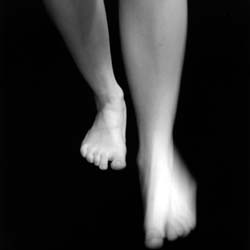![[MetroActive Features]](/gifs/feat468.gif)
[ Features Index | Sonoma County | MetroActive Central | Archives ]
Foot Fetish
Dan Burden walks the talk--a pedestrian-friendly world
By Janet Wells
CALL IT AN EPIPHANY. Twenty-five years ago Dan Burden and his wife, on a bicycle trip from Alaska to Argentina, stopped in Anaheim, where they decided to take a break from their bike seats and walk to a movie in town. "It was only a mile and a half, but we ran into obstacle after obstacle and realized that you couldn't walk in America," says Burden, who was inspired by the experience to develop strategies for creating pedestrian- and bicycle-friendly cities.
As founder and director of Walkable Communities Inc., Burden spent 357 days last year on the road, giving slide shows, lectures, and training workshops on such esoteric-sounding topics as "traffic calming."
Burden, who will offer similar workshops in Petaluma--a city that has an ambitious downtown walking plan--on June 18 and 19, is chatting about "walkability" on a cell phone while conducting a pedestrian audit of downtown Palo Alto, a city he says "pushes a high nine" on a walkability scale of one to 10. Turning a community into a pedestrian paradise goes beyond speed bumps and stop signs, says Burden, who describes a foot-friendly community in five words: security, comfort, convenience, efficiency, and welcome.
Mixed-use, higher-density development makes communities more convenient, and quality planning and construction leads to efficiency, he says. "Security, well, you want to stay away from dark alleys and scary spots. Comfort, that calls for all kinds of amenities, like shade, places to sit, ways to get a drink of water, places to go to the bathroom. Welcome is even harder," he adds. "Aesthetics, making it pleasing, even tantalizing. It's how to get people out of a car."
Stephen Weinberger, a traffic engineer with the Santa Rosa consulting firm W-Trans, has attended several of Burden's workshops and believes that a good pedestrian plan must be compatible with other transit options. "Traditionally, traffic engineers have been viewed as professionals who do facilities for the car," he says. "It's our firm's opinion that we need to consider all forms of transportation. There has been a growing awareness of pedestrian and bicycle issues over the last five years or more.
"A downtown core needs to be as accessible to a pedestrian as to a car," he adds. "The parking, the traffic circulation, the pedestrian facilities all need to work together to bring people in and allow them to walk around."
Is Santa Rosa a good example of a walking city? Weinberger laughs, then tries to be diplomatic. "There are some communities that are much more walkable than Santa Rosa," he says. "The city has been increasing bicycle facilities through use of some of the creek trails and bike lanes."
Several of the recommendations made by a national urban-design team that visited Santa Rosa last year addressed the downtown's decidedly unfriendly layout that features an underutilized central square, bisection of the downtown by a major highway, a dearth of bike lanes, and more than a few busy intersections with heart-stopping crosswalks. The city recently received a $500,000 grant from the regional Metropolitan Transportation Commission to forge ahead with one of the recommendations to create a pedestrian link from Fourth Street to the orphaned Railroad Square.
"Anything that works toward making a strong pedestrian connection between Railroad Square and Courthouse Square would be high on my list," Weinberger says of making downtown Santa Rosa a walkable city. "You'll find a lot of downtowns that have seen an economic revitalization; a number of those were started from improvements to the streetscape, the circulation system, incorporating changes to parking, traffic calming."
Calming traffic does not involve New Age chanting or meditation. Rather, the stress relief comes from "changing the behavior of motorists to have them be more civil toward pedestrians," Burden says. Narrower streets, landscaping, and--Burden's favorite--replacing intersections with mini-circles and roundabouts all result in increased safety by slowing motorists down.
Burden praises Arcata's central plaza in Humboldt County and parts of Davis as examples of what makes for good walkable cities in Northern California. But the best in the world, he says, is Melbourne, Australia. "As recently as 20 years ago, it was considered the most dangerous place for traffic in the industrialized world. Now, statistically, it's the safest, and it was voted the most livable," he says. "They changed their planning, built higher-density, mixed-use projects, narrowed the streets, and put in hundreds and hundreds of roundabouts and good transit delivery.
"America is in its most prosperous decade ever, and each of us is making more expendable income," Burden adds. "But we're dumping our money into ridiculous things that don't matter. Cities that care put money into things that do matter--downtowns, planting lots of trees, making things more livable.
"If we want to go forward, we spend the money upfront."
[ Sonoma County | MetroActive Central | Archives ]
Copyright © Metro Publishing Inc. Maintained by Boulevards New Media.
![]()

Michael Amsler
Dan Burden will talk on "Creating Walkable Communities" on Friday, June 18, at the Mystic Theater in Petaluma. The cost is $35. On Saturday, June 19, Burden will lead a free pedestrian audit-training workshop at the Petaluma Community Center in Lucchesi Park. For more information, call 415/488-4101.
From the June 10-16, 1999 issue of the Sonoma County Independent.